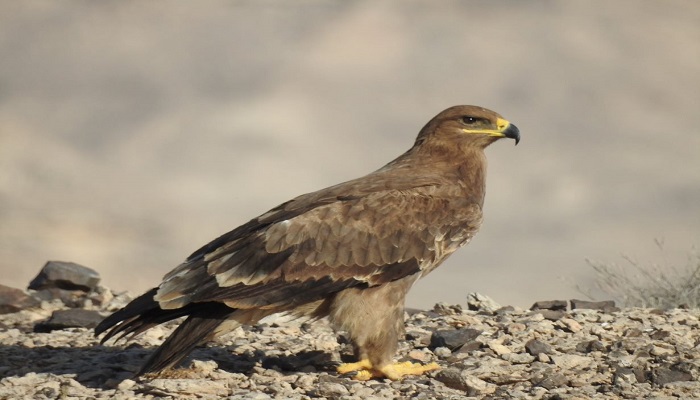
Muscat: The Office for Conservation of Environment recorded a remarkable decline in the number of Steppe Eagles by more than 80 per cent in parts of Dhofar within one year. Steppe Eagles are migratory birds that visit the Sultanate in winter every year.
Khalid bin Muhammad Al Hakmani, Head of the Natural Reserves Department at the Salalah Environmental Conservation Office and the supervisor of the specialised environmental study, said, “The preliminary results of the study showed a significant decrease in the number of migratory Steppe Eagles, with a decrease of 84 per cent during the study period, compared to 2019-2020, specifically during the months between (October until the end of December) every year.”
“The estimated number of Steppe Eagles visiting the Dhofar Governorate in 2019 was about 500, while their estimated number in 2020 was only 80. This is likely due to a number of threats, the most important of which is the lack of food like carcasses (dead animals or their remains),” Al Hakmani added.
The study results also indicated that the Steppe Eagle spends the summer period in Central Asia and migrates with the beginning of October to southern Arabia, especially the Sultanate, Yemen, and southwestern Saudi Arabia. And in the spring, often in March, it leaves the winter regions and returns to the summer regions of Central Asia.
The Environmental Conservation Office of the Diwan of the Royal Court has carried out a specialised field study on the Steppe Eagle within an international cooperation with a team of ornithologists from Austria and Germany, and with the participation of the British Omani Society, from 2018 until now.
The study aimed to identify the behaviours and track the migration paths of this species of raptors in the Sultanate of Oman and the world, and to collect, more accurate and specialised information and publish scientific papers on it to enhance knowledge and environmental awareness, so as to boost efforts to preserve the wildlife, especially animals and plants under threat of extinction.
The preliminary results have shown a clear fall in the number of Steppe Eagle for many reasons, the most prominent of which is a decrease in food at the feeding sites in landfills.
Khalid Al Hakmani, explained, “The Steppe Eagle, with the scientific name Aquila nipalensis, is one of the globally threatened birds according to the Federation’s classification.
The International Conservation Centre (IUCN) considers the Sultanate one of its natural strongholds during the winter season, as large numbers of these eagles visit various sites in the Governorate of Dhofar where appropriate food is available for them.
The characteristics of the medium and large eagle are dark brown, while the young often have a white stripe on the lower length of the wing.
While the sex of the bird can only be identified through a blood test, in general males are smaller than females, where the weight of an adult female ranges between 2.3 - 4.9 kg, and the weight of the male ranges between 2.5 - 3.5 kg.
These types of birds of prey feed on carrion (dead animals), rodents, medium-sized mammals, other birds, and various reptiles and insects.
Regarding the content of the study, Al-Hakmani said, “Thanks to a joint work between the Office for Conservation of Environment at the Diwan of the Royal Court and international specialists for the purpose of preserving and promoting research and protection of birds in the Sultanate of Oman. We have worked together since the beginning of the specialised environmental study project in 2018 to focus on knowing the behaviour and counting the numbers of Steppe eagles in the Dhofar Governorate.
The research team also worked on installing satellite tracking devices on 13 Steppe Eagle in order to provide all the important required data that reach us first-hand and help us monitor accurate information.”
The office carried out field visits to important sites frequented by Steppe eagles to monitor and record important information, count its numbers, and work on analysing that information in a specialised scientific way.
Al Hakmani indicated, “The current data available at OCE confirms the death of three of the thirteen birds on which the satellite tracking devices were installed. The research team investigated the matter, where they found in the meantime that one of these devices is still sending its signals from a fixed location in the Rumaila area in the Governorate of Dhofar, and after a search of the place, the remains of one of the dead eagles were found scattered over it.”
“We thank the cooperating parties here, namely: the British Omani Association and International Bird Research, the Brend Meyberg Foundation for Research and Conservation of Birds of Prey, the Arid Land Organisation, and the Omani Environmental Services Holding Company (Be’ah). We also commend the community and civil cooperation and support for all environmental projects implemented by the office,” he added.
It is worth noting that the Environmental Preservation Office of the Diwan of the Royal Court affirms the continuation of the existing and fruitful cooperation with the various environmental agencies and relevant authorities, whether inside or outside the Sultanate, to come up with the best results and recommendations, raise perceptions for those concerned, strengthen policies and instill environmental culture in the Omani society.
It also stresses the continuation of monitoring the migration routes of the Steppe eagle and counting its numbers and behaviour in the Dhofar Governorate to preserve and protect it for the sake of Oman and future generations.